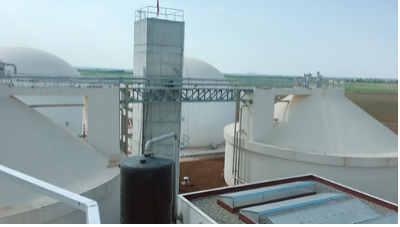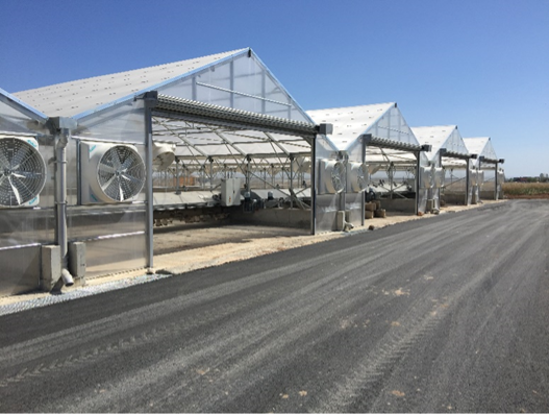
Sludge Management
Sludge treatment
Conversion of residues into an energy source.


Sufficient wastewater treatment is a critical aspect of WABAG’s approach, and it encompasses a crucial component: Sludge treatment.
During sewage treatment processes sewage sludge is produced as a by-product. The resulting mixture of primary, secondary, and in some cases also tertiary sludge, known as “raw” sewage sludge, contains 0.5 to 3 % solids and poses potential health and environmental risks due to its pathogen content and decomposable nature.
To address these concerns, various treatment processes are employed to stabilize the sludge, decrease pathogen levels, and increase solids content, reducing its mass and size, and thereby reducing disposal costs. These processes are essential for managing sewage sludge effectively while minimizing its impact on health and the environment.
Two classic processes are available for correct sludge treatment:
Aerobic sludge stabilization takes place in sludge tanks with the injection of air. Aeration and agitation needs more energy than in case of anaerobic stabilization
Anaerobic sludge stabilization constitutes the best solution for sewage plants with medium to large design capacity (from approx. 20,000 PE) with regard to costs, energy efficiency and environmental protection. Moreover, combustable biogas results from controlled digestion and this can be used for energetic purposes.
Energy Optimized Sludge Treatment – the WABAG ENOPUR® system:
WABAG offers complete solutions for state-of-the-art sludge treatment including pre- and post-treatment like sludge thickening, dewatering, drying and incineration.
The WABAG ENOPUR® system encompasses anaerobic sludge stabilization and corresponding pre-and post-treatment steps as well as nutrient recovery providing advanced and sustainable sludge management solutions. WABAG creates ideal plant designs with regard to effectiveness, cost efficiency and environment-friendliness using all its comprehensive experience as an international plant builder.
Our company has been installing and operating anaerobic sludge treatment plants since many years and have extensive know-how and experience for this specific task. With over 70 plants installed during the past 30 years, successfully generating >40 MW of clean and renewable energy.
What makes WABAG a preferred partner:
· Comprehensive experience in the design, construction and operation of complete WWTPs including anaerobic sludge digestion systems.
· Proven process know-how and expertise as well as an understanding of entire systems.
· Experience as plant operator: based on DBO as well as O&M outsourcing schemes.
· Special capabilities with regard to the retrofitting and upgrading of existing plants.
· Top quality completion standards
· In-house R&D centres guarantee the continuous optimization of current systems.
Explore project examples:
Introducing a “Waste-to-Energy” concept for the Rithala WWTP in India: modernization of the 182 MLD WWTP and extension with anaerobic sludge digestion and biogas utilization. This initiative was part of the YAMUNA Action Plan.
The existing wastewater treatment plant in Rithala, with a capacity of 182,000 m3/d, has undergone comprehensive modernization, featuring the addition of an anaerobic sludge treatment system that includes power generation.
The project involves both the modernization of the existing three-stage plant technology of the wastewater treatment facility – mechanical/biological with final filtration and disinfection – as well as its expansion through the construction of an anaerobic sludge treatment and biogas plant.
During the modernization, sludge produced during the biological wastewater treatment process is anaerobically stabilized in six digestion towers, each with a volume of 4,615 m3. The biogas generated during this digestion process is converted into energy (both electricity and heat) in a co-generation plant with a capacity of 2 MW. This sustainable approach renders the wastewater treatment plant energy-neutral and ensures its self-sufficiency in operations.
The plant, commissioned in 2024, was realized on a Design-Build-Operate (DBO) basis and includes 11 years of Operation & Maintenance (O&M) services. –
Elevating sustainability: Şanlıurfa Metropolitan Municipality Wastewater Treatment Plant sets new standards in sludge management






WABAG has pioneered an innovative approach at the Şanlıurfa Metropolitan Municipality Wastewater Treatment Plant, integrating state-of-the-art wastewater treatment with advanced sludge management. This plant, boasting one of the world’s largest solar drying beds spanning 24,000 m2, not only efficiently treats a total of 144,800 m3/d of wastewater from 700,000 people but also repurposes the dried sludge, free of heavy metals and contaminants, as high-quality fertilizer, representing a significant milestone in the region’s environmental initiatives.
During wastewater treatment, the plant generates electricity through a comprehensive sludge treatment process, which includes thickening, anaerobic digestion (comprising 3 digesters each with a volume of 5,400 m3), biogas utilization in a Combined Heat and Power Plant (CHPP) with a capacity of 1.8 MW, thickening, dewatering, and solar sludge drying. The utilization of biogas covers 75% of the plant’s energy requirements, further enhancing its sustainability credentials.
Explore our innovative ENOPUR® – Energy Optimized Sludge Treatment technologies for sustainable sludge management:


